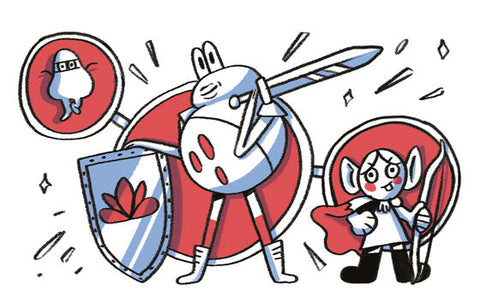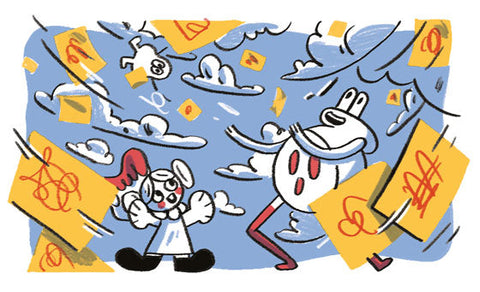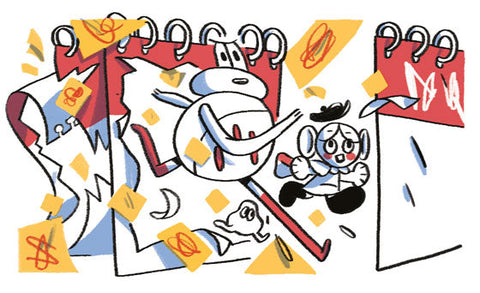Do you think of yourself as a facilitator? If you’ve ever organised a meeting, you’ve occupied that role whether you recognised it or not.
Whilst real-time meetings are becoming less common in some organisations, many of us are having more meetings than ever. Given that meetings take up so much of our time, isn’t it a bit weird how little we talk about what it means to lead them well? In most organisations, people are left to figure this stuff out for themselves.
If you’re lucky, you might get to see a skilled facilitator or two in action at some point in your career, and some of their magic might rub off, but most of us don’t learn to facilitate in a structured, deliberate way.
Often, the most confident people in a given setting will tend to assume this role – that’s a shame, because confidence alone doesn’t make you a good facilitator. In fact, people with more introverted traits can be incredible facilitators with the right mindset and methods.
This post covers some foundational ideas about this essential but often underappreciated role.
What difference does a good facilitator make?
Have you ever been in a brainstorm that felt so awkward you wanted to disappear, and didn’t lead to any breakthrough ideas?
Have you ever been in a meeting where the loudest or most senior person dominated, and someone else hardly said a word?
Have you been in workshops that felt like a waste of time, or didn’t lead to any clear decisions?
Good facilitators solve these problems and more. The role of a facilitator changes depending on the context, but there are some key themes:
- Creating the conditions for creativity, so brilliant ideas are easier to find
- Making space for diverse perspectives to be heard, which leads to better decisions
- Cementing a sense of shared purpose, enabling people to act coherently as a group
- Helping people learn something new (about themselves, each other, or their users)
What skills does a facilitator need?
Facilitation is all about bringing people together and helping them do their most creative, effective, and meaningful work. Obviously it helps to have some mastery of the various tools of the trade, but emotional intelligence is what really sets great facilitators apart:
“Leading effectively is less about mastering situations, or even mastering social skill sets, than about developing a genuine talent for fostering positive feelings in the people whose cooperation and support you need.”
— Daniel Goleman and Richard E. Boyatzis (experts on emotional intelligence in organisations)
I realise that might sound a little woolly, so let’s break down some of the key “soft” skills that facilitators deploy:
Communication
You don’t need to speak with a certain accent or look-who-did-drama-GCSE flamboyance to be a great facilitator. Don’t get me wrong – there is an element of performance involved – but you should focus on embodying your own authentic style with conviction, rather than second-guessing what others might expect a facilitator to sound like.
However you communicate, though, you need people to understand what you’re asking them to do and why. People need to feel like you know what you’re doing, so everything from the meeting invite onwards matters. Pay careful attention to:
Emails or calendar invites before a session
Proofread everything, make the purpose and expected outputs clear, and build a bit of excitement.
Welcoming people when they arrive
A friendly and enthusiastic welcome sets the tone for the rest of the session.
Introducing activities
Wait for quiet before giving instructions. Then, explain the steps like you’re talking to five-year-olds, but also explain the point of each exercise for extra credibility.
Giving feedback
Be generous with positive reinforcement when people share ideas – this spans from a simple “nice!” to “I love that idea, because…”.
Wrapping-up
Always aim to give people a sense of closure with a clear summary of next steps and a simple check-out activity that lets them reflect on the session.
Active listening
When we talk about leading meetings, it’s natural to focus on all the things we’ve just discussed above; carefully shaping the experience and making sure you’re understood.
But this really isn’t all about you.
As facilitator, it’s your job to:
Listen carefully to the contributions people share
And then reiterate them so people feel heard, and so others can more easily absorb the information.
Listen to what’s not being said
And ask interested, curious questions to unearth the deeper meanings behind what people share and help the group access important truths that are usually hidden.
Pay attention to people’s emotional energies
Are they showing signs of stress, fear, or boredom? How might you counterbalance that?
Keep ideas flowing
Simply asking “what else?” is a facilitator’s secret weapon.
Facilitator as vibe merchant
I have observed, again and again, that the atmosphere you foster as a facilitator makes all the difference.
There’s much to learn from the way a seasoned Maître d' greets guests, the way a skilled DJ senses and responds to the energy of a crowd, or the dynamics of a well-hosted dinner party.
We can also learn from the alternate realities people visit using LSD or psychedelic plants. Stick with me here… In these experiences, “set and setting” are critical; the mindset someone arrives with (e.g. fear vs curiosity) and the environment in which it takes place (e.g. bedroom vs forest) can completely change the nature of what occurs. These are principles we too can apply.
Influencing the “set”
The mindset participants bring to any meeting or collaboration session will always be somewhat beyond your control. Humans arrive with all kinds of mental baggage, from work, from home, and from the wider world. But that doesn’t mean you have no influence at all – you can prime people to be their most engaged and creative selves both before and during any gatherings.
You can do this by:
- Sending out an email the day before a session to remind people what’s happening and lead by example, resonating enthusiasm
- Giving people interesting prep tasks to do before you meet so they’ve had a chance to get their heads into the topic or challenge by the time you get together
- Incorporating icebreakers and energisers into your sessions to help people lower their guard and participate more fully
Influencing the “setting”
Exactly how you curate the environment for a session will depend on where it’s taking place and whether it’s in-person, hybrid, or remote.
Aim to have fewer meetings, but do more of them in-person if you can – the idea is to be more intentional about when and why you gather together, and there are more ways you can influence the atmosphere when you’re all in the same physical space.
The space
If you’re working in a room together, be deliberate about the details, like how you arrange seating and what you stick on the walls before people arrive.
“A workshop is an experience you are inviting people to. When you walk into a theatre for a show, you don’t want to see the set designers fixing the stage or the actors rehearsing. When the team walk into the workshop, be ready to greet them, make them welcome, let them settle. Don’t make them watch you setting up slides, rushing about unpacking materials or writing on flipcharts.
“One of the main things I think about when I set up the room is what people will see as soon as they walk in. Is there a prominent wall opposite the door that you can decorate? Are there blinds that have stayed close for 20 years that you can open and let some light in?”
— Pamela Hamilton, The Workshop Book
Refreshments
Don’t underestimate the importance of providing the right food and drink – keeping people hydrated, energised and well-rewarded with plenty of healthy refreshments (and some optional sugar / caffeine) is all part of facilitating an effective session if you’re gathering for any more than an hour.
Music
Finally, music is a seriously under-used tool for modulating the vibe in meetings – avoid anything with lyrics, and check people are OK with some background beats, but otherwise experiment with different moods and tempos to shift the atmosphere and help keep people in flow. Here’s a brainstorming playlist from Asana if you’re not sure where to start.









